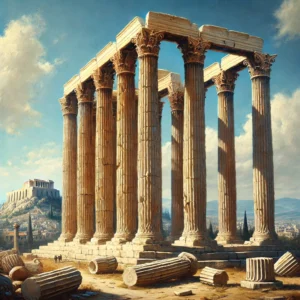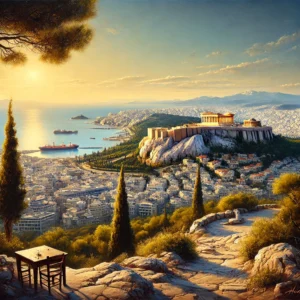Nestled at the foot of the Acropolis, the Ancient Agora of Athens is one of the most significant archaeological sites in the world. Once the beating heart of ancient Athens, the Agora was not just a marketplace but also a hub of political, social, and cultural life. From philosophical debates to monumental trials, the Agora was where democracy, philosophy, and civic life flourished. Today, a visit to the Agora offers a unique glimpse into the daily life of ancient Athenians, along with stunning ruins that date back thousands of years.
Let’s take a tour through this remarkable site and explore its key landmarks, history, and the hidden gems that make the Ancient Agora a must-see for any traveler to Athens.
The History of the Ancient Agora
The word “agora” in ancient Greek means “gathering place” or “assembly”, and that’s exactly what the Agora was for the people of Athens. Established in the 6th century BCE, it served as the central marketplace and meeting point for citizens. More than just a commercial space, it was where Athenians gathered to discuss politics, engage in public debates, and participate in civic and religious life.
The Agora is most famous for being the birthplace of democracy. It was here that the Athenian Assembly would meet to make important decisions about the city’s governance. Philosophers like Socrates wandered the Agora, engaging citizens in thought-provoking discussions, while famous statesmen like Pericles addressed the people. Trials, festivals, and religious ceremonies were held in its open spaces, making it a vibrant focal point of ancient Athens.
Key Landmarks of the Ancient Agora
As you explore the ruins of the Ancient Agora, several key landmarks stand out, each with its own rich history.
1. The Stoa of Attalos
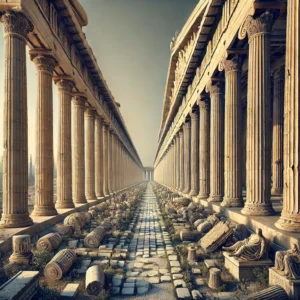
One of the most impressive buildings in the Agora is the Stoa of Attalos, a grand covered walkway rebuilt in the 1950s. Originally constructed in the 2nd century BCE by King Attalos II of Pergamon, this long colonnaded building was a central spot for shopping, socializing, and conducting business. Today, the Stoa houses the Agora Museum, which showcases artifacts discovered at the site, including pottery, statues, and ancient tools that offer a window into Athenian daily life.
2. The Temple of Hephaestus
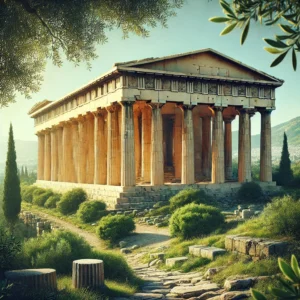
Perched on a hill overlooking the Agora is the Temple of Hephaestus, one of the best-preserved ancient temples in Greece. Built in the 5th century BCE, this Doric temple was dedicated to Hephaestus, the god of fire and metalworking, and Athena, the goddess of craftsmanship. The temple’s nearly intact columns and friezes depict scenes from Greek mythology, and the surrounding gardens offer a peaceful retreat with stunning views of the Acropolis.
3. The Tholos
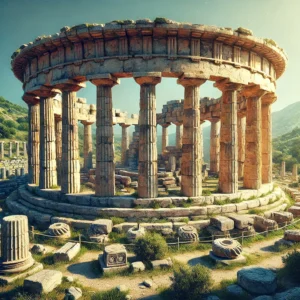
The Tholos was a circular building that served as the headquarters for the Prytaneis, a group of 50 men chosen by lot to oversee the daily business of the Athenian government. It was here that they held official meetings and even had their meals. Though only the foundation of the Tholos remains today, it’s a powerful reminder of the democratic system that was central to ancient Athens.
4. The Odeon of Agrippa

In the center of the Agora, you’ll find the ruins of the Odeon of Agrippa, a large concert hall built in the 1st century BCE. This structure could hold up to 1,000 people and was used for musical performances, lectures, and other public events. Though much of the building has been lost over time, the towering giant statues that once adorned the entrance still stand, giving a sense of its grandeur.
5. The Altar of the Twelve Gods

One of the most important religious sites in the Agora was the Altar of the Twelve Gods, built in the 6th century BCE. This altar was dedicated to the twelve Olympian gods and served as a central point for sacrifices and offerings. It was also the “zero point” from which distances to other parts of the city were measured.
Hidden Gems of the Agora
While the major monuments are awe-inspiring, there are also lesser-known gems hidden throughout the Agora.
- The Socratic Legacy: The Agora is closely associated with the philosopher Socrates, who was famously put on trial here. As you wander the site, it’s easy to imagine Socrates engaging in his famous dialogues, challenging the citizens of Athens to think critically about life, morality, and governance.
- The Painted Stoa (Stoa Poikile): Though only the foundations remain, the Painted Stoa was once a beautiful building decorated with murals depicting famous battles, such as the Battle of Marathon. It was a popular meeting place for philosophers of the Stoic school, who took their name from this very building.
- The House of Simon the Shoemaker: If you’re a fan of philosophy, look for the remains of Simon’s house, believed to be the shop where Socrates would converse with locals. Simon was a follower of Socrates, and his humble home is one of the few places in Athens linked to the philosopher’s daily life.
Tips for Exploring the Ancient Agora
To make the most of your visit to the Ancient Agora, here are a few helpful tips:
- Wear Comfortable Shoes: The Agora covers a large area, and the ground can be uneven, so be sure to wear comfortable footwear for walking over ancient ruins.
- Visit Early or Late: Like many of Athens’ popular sites, the Agora can get crowded during peak hours. Visiting early in the morning or late in the afternoon allows you to explore the site in relative peace, and the soft light is perfect for photography.
- Bring Water and Sunscreen: There’s little shade in the Agora, especially in the summer months, so be sure to bring water and protect yourself from the sun.
- Combine It with a Visit to the Acropolis: The Agora is located just a short walk from the Acropolis, making it easy to combine the two into a single day of exploring Athens’ ancient wonders.
- Check Out the Museum: The Agora Museum in the Stoa of Attalos is a great way to deepen your understanding of the site. The artifacts on display help bring the ruins to life, providing insight into the everyday lives of ancient Athenians.
Bringing the Past to Life
The Ancient Agora of Athens isn’t just a collection of ruins—it’s a living reminder of the birthplace of democracy and a hub of intellectual and civic life. Walking among its temples, stoas, and public buildings, you can almost hear the echoes of ancient debates, the clamor of market stalls, and the hum of Athenian life.
Whether you’re a history enthusiast, a philosophy lover, or simply a curious traveler, a visit to the Ancient Agora is an essential stop on any tour of Athens.
Enhance your visit with our digital city tour map, which includes audio guides, videos, and walking routes to help you explore the Agora’s landmarks and hidden gems. Get ready to step back in time and experience Athens like never before!



